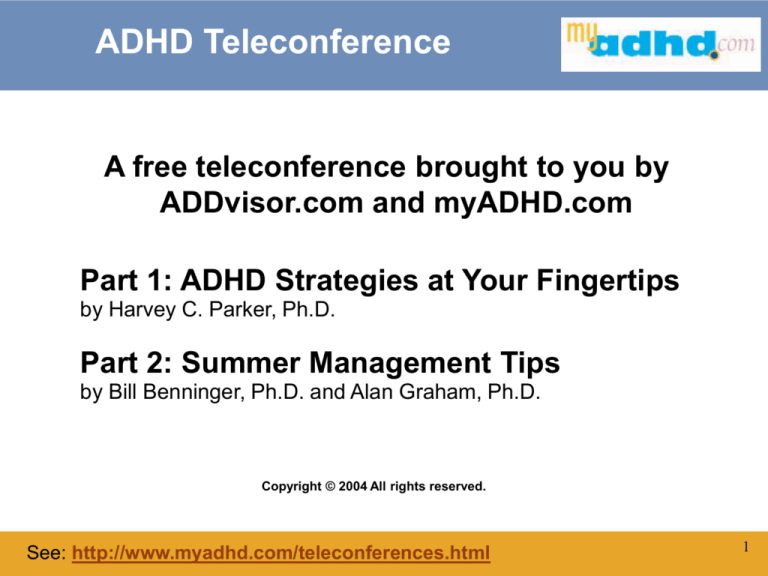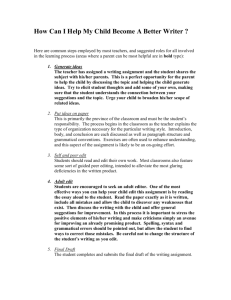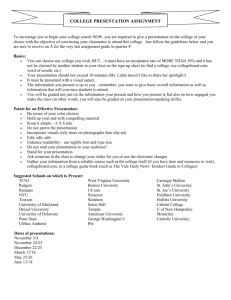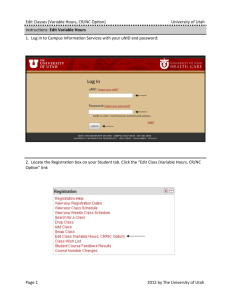
ADHD Teleconference
A free teleconference brought to you by
ADDvisor.com and myADHD.com
Part 1:Click
ADHD
at Your
Fingertips
toStrategies
edit Master
title style
by Harvey C. Parker, Ph.D.
Part 2: Summer Management Tips
by Bill Benninger, Ph.D. and Alan Graham, Ph.D.
Copyright © 2004 All rights reserved.
See: http://www.myadhd.com/teleconferences.html
1
Disclaimer
These slides and the accompanying presentation
provide a general overview of strategies to
manage attention-deficit/hyperactivity
disorder
Click to edit Master title style
(ADHD) and related conditions and do not
constitute medical, psychological, educational, or
legal advice. Please consult your own health care
provider or other professional for specific advice.
2
Finding Answers for ADHD
• What is ADHD?
• How does ADHD affect daily living?
• What causes ADHD?
• What procedures are used to assess ADHD?
Click towork
editbest?
Master title style
• What treatments
• How can assessment tools, tracking tools, and
treatment tools from myADHD.com help families,
practitioners, educators, and adults?
• Management Tips
3
What is ADHD?
• …A medical condition characterized by
inattention and/or hyperactivity-impulsivity.
• …One of the most common mental disorders
Click to edit Master title style
among children, affecting approximately 5 to
7 % of school-age children and about 2-5%
of adults
4
Prevalence in the United States
About 2 million children
Click to edit Master title style
About 5 million adults
5
Prevalence World Wide
•
•
•
•
•
•
•
•
•
•
•
Canada
Australia
New Zealand
Germany
India Click to
China
Netherlands
Puerto Rico
Japan
Mexico
Brazil
edit
3.8-9.4% kids
3.4% of kids
6.7% kids, 2-3% teens
4.2% children
5-29% children
Master
title style
6-9% children
1.3% teens
9.5% child & teens
7.7% children
approx. 5% children
5.8% of 12-14 year olds
6
Adult ADHD Remains Largely
Undiagnosed*
15% Diagnosed
Click to edit Master title style
85% Undiagnosed as an Adult
*1999 analysis of a 1000 adult patient epidemiological database.
Data on file, Lilly Research Laboratories.
7
ADHD is Not a Problem of:
• Will power
• Inadequate parenting
• Lack of motivation
to edit Master title style
• Lack of Click
intelligence
• Laziness
8
ADHD is a neurological disorder
that impairs
• Regulation of attention
• Regulation of motor activity
• Regulation of impulsivity
Click to edit Master title style
9
ADHD results in problems with
•
•
•
•
•
•
•
Planning
Organizing
Starting and stopping activity
Managing behavior
Persisting
on tasks
Click
to edit Master title style
Problem solving
Working memory
These are called Executive Functions
10
DSM-IV Criteria:
6 of 9 Inattention Symptoms
•
•
•
•
•
•
•
•
•
Fails to give close attention to details
Difficulty sustaining attention
Does not seem to listen
Does not follow through on instructions
Difficulty Click
organizing
tasks Master
or activities
to edit
title style
Avoids tasks requiring sustained mental effort
Loses things necessary for tasks
Easily distracted
Forgetful in daily activities
11
DSM-IV Criteria:
6 of 9 Hyperactive-Impulsive
•
•
•
•
•
•
•
•
•
Fidgets with hands or feet or squirms in seat
Leaves seat in classroom inappropriately
Runs about or climbs excessively
Has difficulty playing quietly
Is “on theClick
go” or to
“driven
a motor”title style
editbyMaster
Talks excessively
Blurts out answers before questions are completed
Has difficulty awaiting turn
Interrupts or intrudes on others
12
Other DSM-IV Criteria
•
•
•
•
•
•
•
Developmentally Inappropriate Levels
Duration of 6 Months
Cross-setting Occurrence of Symptoms
Impairment in Major Life Activities
to edit Master title
Onset ofClick
Symptoms/Impairment
by style
7
Exclusions: Severe MR, PDD, Psychosis
Subtyping into Inattentive, Hyperactive, or
Combined Types
13
AAP Assessment Guidelines
• Diagnosis must meet DSM IV criteria
• Evidence of symptoms and impairment must come
from parents or caregivers
• Evidence of symptoms and impairment must come from
classroom teacher or other school professional
• AssessmentClick
shouldto
include
for co-morbid
edit evaluation
Master title
style conditions
• Rating scales designed specifically to assess ADHD symptoms
should be used in addition to narrative reports, observations,
etc.
• Other diagnostic tests are not routinely used to establish
presence of ADHD but may be used to discover other
conditions
14
Potential Areas of Impairment
Occupational/vocational
Motor vehicle accidents
Injuries
Click to edit Master
title style
Smoking and SUD
Legal difficulties
Relationships
Academic failure
15
ADHD has a Neurobiological
Basis
• Dysfunction of
dopaminergic and
noradrenergic systems
Clickand
to edit Master
• Dopamine
norepinephrine are
important in drugs that treat
ADHD
title style
Arnsten AF. J Psychopharmacol 1997;11:151-62; Madras BK, et al. Behav Brain Res 2002;130:57-63; Russell
VA. Behav Brain Res 2002;130:191-6; Solanto MV. Behav Brain Res 2002;130:65-71.
16
How do you get ADHD?
Click to edit Master title style
17
ADHD Is highly heritable
Depression
IQ
Click to edit Master title style
Schizophrenia
ADHD
Height
0
0.2
0.4
0.6
0.8
Heritability
estimate
Heritability
Estimate
Faraone SV, et al. Child Adolesc Psychiatr Clin N Am 2001;10:299-316, viii-ix; Faraone SV, et al. Am J
Psychiatry 2001;158:1052-7; MARK Web site.
18
Causes of ADHD
• Heredity/Genetics
• 25-30% siblings
• 15-20% mothers
55-92% identical twins
25-30% fathers
• Neurological Development
Click to edit Master title style
• Complications of pregnancy, fetal exposure to alcohol
or tobacco, premature birth with minor brain
hemorrhages (10-15%)
• Head trauma, brain hypoxia, infection, lead poisoning
during early childhood (3-5%)
19
Common Comorbid Diagnoses
0
10
20
30
40
50
60
Oppositional
defiant disorder
Conduct
disorder
Click to edit Master title style
Mood disorder
Anxiety
disorder
Learning
disorder
Biederman et al. JAACAP 1996;35:343.
Biederman et al. JAACAP 1999;38:966.
Pliszka. J Clin Psychiatry 1998:59(suppl 7):50.
Spencer et al. Pediatric Clin N Am 1999:46:915.
20
AAP Treatment Guidelines
• Primary care physicians should establish treatment
programs for ADHD
• Clinicians, parents, teachers, and children should
collaborate to target outcomes
Click to edit Master title style
• Medication and/or behavior therapy are appropriate
treatments
• Periodic, systematic follow-ups for the child should be
done with monitoring for targeted symptoms.
Information should be gathered from parents,
teachers, and the child.
21
How can we help people with
ADHD?
Treatments for ADHD
•Education
•Medication
•Behavior
Modification
Click
to edit Master title style
•Classroom/Workplace Accommodations
22
MTA Study—The Largest Study
Comparing ADHD Treatments
Which ADHD treatments (or combination) work best?
1. Medication (MedMgt) vs. Behavioral Tx (Beh) vs.
Combination (Comb) over the long term
Click to edit Master title style
2. State-of-art, intensive MTA treatments vs. standard
care available in the community (CC), over the long
term
See: http://www.myadhd.com/articles.html
23
Co-Occurring Disorders in
MTA Children (n=579)
ADHD alone
31%
Tic
11%
Dis..
Dis
Oppositional
Defiant Disorder
40%
Click to edit Master title style
Conduct
Disorder
14%
Mood
Dis.. 4%
Dis
Anxiety 34%
Disorder
24
MTA Study—Treatment Groups
Four Treatment Groups (14 months)
1. Medication alone (MPH dosed to last 12 hours)
2. Intensive behavioral treatment alone
a. over 30 sessions for parent training
Click to edit Master title style
b. 8 week summer program
c. behavior therapist for 12 wks in classroom
d. daily reports from school to home
3. Combined medication & behavioral treatment
4. Community-based care (control)
Source: MTA Study Group, Arch Gen Psych, 1999, 56, 1073-1086.
25
MTA Study Results
All treatment arms found to be effective on an absolute basis
Medication alone
Medication + behavioral
treatment
Click to edit Master title style
Nearly equally effective
and superior to:
• Behavioral treatment alone
• Community based treatment
Source: MTA Study Group, Arch Gen Psych, 1999, 56, 1073-1086.
26
% “Normalized” at 14-Month Endpoint
MTA Groups vs Classroom Controls
100%
80%
60%
88%
68%
Click to edit Master title style
56%
40%
34%
20%
0%
Controls Comb
Med
Beh
25%
CC
Swanson, JM, et al. J. Amer Acad Child Adolesc Psychiatry
, 2001; 40 (2); 168-179.17
27
Commonly Used Stimulant
Medications for ADHD
• Methylphenidate (MPH) Products
• Ritalin
short & mid-acting forms
• Concerta
long-acting
• Metadate CD
mid-acting
• Ritalin Click
LA
mid-acting
to edit
Master title style
• Focalin
mid-acting
• Amphetamine Products
• Adderall
mid-acting
• Adderall XR
long-acting
• Dexedrine
mid-acting spansule
• Dextrostat
mid-acting
Short acting = 3-5 hours; Mid-acting = 6-8 hours; Long acting = 12 hours+
28
Commonly Used Non-Stimulant
Medications for ADHD
•
Nonstimulant Products
• Strattera
long-acting
• Other Nonstimulants Products
• Wellbutrin
long-acting
Click to edit
Master title style
• Tenex
mid-acting
• Clonidine
mid-acting
Short acting = 3-5 hours; Mid-acting = 6-8 hours; Long acting = 12 hours+
29
Efficacy of Medication for ADHD
• Improvements in core symptoms
reduced hyperactivity
reduced impulsivity
improved attention
Click to edit Master title style
• Improvements in related symptoms
reduced oppositional behavior
Improved social relations
improved academic performance
Short acting = 3-5 hours; Mid-acting = 6-8 hours; Long acting = 12 hours+
30
Adverse Effects of Stimulants
insomnia
decreased appetite
weight loss
headache
irritability
Stomachache
Click
to edit ofMaster
titlesymptoms
style as it is
rebound agitation
or exaggeration
pre-medication
wearing off
Precautions
Use cautiously in patients with marked anxiety, motor tics or with family
history of Tourette syndrome, or history of substance abuse. Don't use if
glaucoma or on MAOI. Abuse potential particularly in tablet form.
Always consult your physician before using ADHD medications.
31
Adverse Effects of Strattera
In children
decreased appetite
GI upset (can be reduced if medication taken with food)
sedation (can be reduced by dosing in evening)
lightheadedness
In adults
Click to edit Master title style
insomnia
sexual side effects
increased blood pressure
Precautions
Use cautiously in patients with hypertension, tachycardia, or cardiovascular or
cerebrovascular disease because it can increase blood pressure and heart rate. Has
some drug interactions. While extensively tested, short duration of population use.
Always consult your physician before using ADHD medications.
32
Using Medication Effectively
• American Academy of Pediatrics recommends that for
treatment of ADHD physicians start with a low dose of
medication and tritrate upward to find the optimal dose.
• Optimal dose
is the
best Master
individualized
response with
Click
to edit
title style
minimal side effects.
• Have a system in place to monitor treatment outcomes
to find the optimal dose and adverse effects.
Short acting = 3-5 hours; Mid-acting = 6-8 hours; Long acting = 12 hours+
33
Treatment for ADHD can be
improved by:
• Empowering parents and providers with accurate
information about best practices
– creating connections between stakeholders and
encourage greater communication
– using an “educate the community” model
Click to edit Master title style
• Developing communication tools
– web-based assessment tools
– “checklists” for parents, teachers and doctors to guide
each one’s role in assessment and treatment
• Forming a coalition of parents, professionals, and policy
makers
34
MyADHD.com Tools
Tools to Empower Providers, Parents, and Adults
• Assessment Tools
rating scales, checklists, and child/adult history forms
• Tracking
Tools
Click
to edit Master title style
rating scales
• Treatment Tools
worksheets for skill improvement
• Library Tools
learning resources (articles, books, newsletters,
announcements, etc.)
35
Assessment Tools
• Vanderbilt Assessment Scale (Parent and Teacher
Informant Versions) (Wolraich, et al.)
• SNAP-IV (18 items) (Swanson, et al.)
• SNAP-IV-C (80 Items) (Swanson, et al.)
• ADHD Symptom Checklist (child and adolescent
version)Click
in English
and Spanish
to edit
Master title style
• ADHD Symptom Checklist (adult self-report and
adult observer-report versions) in English and Spanish
• Childhood Disorders Checklist
• Child and Adolescent History Form
• Adult Psychosocial History Form
• Novotni Social Skills Checklists (self and observer
versions)
See: http://www.myadhd.com/assessmenttools.html
36
Tracking Tools
• SNAP-IV (Swanson, et al.)
• ADHD Symptom Checklist (child and adolescent
version)
Click to edit Master title style
• ADHD Symptom Checklist (adult self-report and
adult observer report versions)
• ADHD Monitoring System (Rabiner, 1999)
See: http://www.myadhd.com/trackingtools.html
37
How Assessment and
Tracking
Tools Can Be Completed
and Sent?
• View form on screen then print and complete and send by mail
or fax.
• Download form as PDF file then print and complete and send by
mail or fax.
Click to edit Master title style
• Transmit form electronically using the Subscriber Administration
Page.
– Select from over a dozen forms (Eng/Span) that you would like to send for completion.
– Send form easily to multiple teachers (e.g., middle/high school) using myADHD.com
address book feature.
– Once received, forms can be archived in your private account. Received forms can be
easily transmitted to others for review.
38
Using Your myADHD.com
Subscriber Administration Page
Click to edit Master title style
QuickTime™ and a
TIFF (LZW) decompressor
are needed to see this picture.
See:http://www.myadhd.com/sampleadminpage1.html
39
Treatment Tools
Worksheets to
improve skills
Click to edit Master title style
for children,
adolescents,
and adults.
See:http://www.myadhd.com/treatmenttools.html
40
Types of Treatment Tools
Children
Behavior Management
Adolescents
Behavior Management
Adults
Organizational Strategies
Click toStudy
edit
Master title
style
Strategies
Career Planning
Study Strategies
Social Skills
Social Skills
Medication Management
Anger Management
Anger Management
Stress Management
41
MyADHD.com Medication Chart
Click to edit Master title style
See:http://www.myadhd.com/treatment_tools/medicationchart.html
42
Daily Report Cart
Click to edit Master title style
See: http://www.myadhd.com/treatment_tools/sample3003dailyreportcard.html
43
Writing Behavior Contracts
Click to edit Master title style
44
Home Token Economy Systems
Click to edit Master title style
See: http://www.myadhd.com/treatment_tools/sample3004hometokeneconomy.html
45
Anger Management Worksheet
Click to edit Master title style
46
Changing Angry Thoughts
Click to edit Master title style
47
Don’t Call Out! Raise Your Hand
Click to edit Master title style
See: http://www.myadhd.com/treatment_tools/sample3009raiseyourhand.html
48
Homework Self-Check
Click to edit Master title style
49
Overcoming Roadblocks to
Family Communication
Click to edit Master title style
See: http://www.myadhd.com/treatment_tools/sample7001familycommunication.html
50
Problem Solving Worksheet
Click to edit Master title style
51
Types of Resumes
Click to edit Master title style
See: http://www.myadhd.com/treatment_tools/sample9007typesofresumes.html
52
Writing an Effective Cover Letter
Click to edit Master title style
53
Keeping a Personal Budget
Click to edit Master title style
See: http://www.myadhd.com/treatment_tools/sample1201personalbudget.html
54
Tackling Housecleaning
Click to edit Master title style
55
Conclusions
• ADHD is a chronic condition that has significant affects on learning,
behavior, socialization, and performance across the lifespan.
• ADHD is prevalent in every country where it has been studied.
• ADHD can persist into adulthood.
Click to edit Master title style
• ADHD treatments have been well studied.
• Multimodal treatments work best and involve a combination of education
about the condition, medication, counseling, behavior management, and
school and workplace accommodations and interventions.
• Enhanced communication among stakeholders (providers, parents,
educators, adults with ADHD) can lead to maximum improvement.
56
Summer Management Tips
Bill Benninger, Ph.D. and Alan Graham, Ph.D.
• Medication
• Structure
• Accountability
Click to edit Master title style
• Social skills
See: http://www.ADDvisor.com
57
Summer Management Tips
Summer Activities to Consider
• Camp
• Sports
• Vacations
Click to edit Master title style
• Summer school
• Jobs
• Family projects
• Tutoring
58
Contact Information
• MyADHD.com
– Email: info@myadhd.com
– Harvey C. Parker, Ph.D.
Phone: (954) 792-8100
• ADDVisor
1-866-ADDvisor
Click to edit Master title
– Bill Benninger
• Email: Bill@ADDvisor.com
• Phone: 1-614-251-0400
– Alan Graham
• Email: Alan@ADDvisor.com
• Phone: 1-847-824-1235
See: http://www.myadhd.com
style
See: http://www.ADDvisor.com
59
Other Resources
Children and Adults with
Attention Deficit /Hyperactivity
Disorders (CHADD)
www.chadd.org
Attention Deficit Disorders
Association (ADDA)
Click to
http://www.add.org/
American Academy of Child and
Adolescent Psychiatry (AACAP)
http://www.aacap.org/
American Academy of Pediatrics
www.aap.org
edit Master
style
A.D.D. title
WareHouse
www.addwarehouse.com
Learning Disability Association of
America
http://www.ldanatl.org/
See: http://www.myadhd.com/organizations.html
60






